 When a major snowstorm hits New England, it can bring inches to feet of frozen precipitation. Knowing how to correctly dig your vehicle out of snow can help reduce superficial damage and more serious issues like rust.
When a major snowstorm hits New England, it can bring inches to feet of frozen precipitation. Knowing how to correctly dig your vehicle out of snow can help reduce superficial damage and more serious issues like rust.
Get started with the following tips.
Preparation
Ahead of a storm, it’s always a good idea to check your tire pressure and treads. Also have your battery examined to make sure it can withstand the cold.
Dress warmly to dig out your car, so you stay comfortable and prevent frostbite. Ideally, you should be equipped with the following tools:
- A soft-bristled brush
- A shovel
- An ice scraper
- A snowblower
- De-icer
- A ladder
- Salt
- Sand or kitty litter for traction
Shoveling Out Your Car
To remain steady, dig out an area near your vehicle where you will be able to comfortably stand. Start with the top of your car, using a shovel, brush or scraper to remove the snow. Beginning here reduces the number of times you’ll need to shovel the ground.
Avoid using the shovel and scraper directly on the paint, as these can leave scratches and attract rust. As you work your way down the vehicle, pay attention to the trunk, doors, tailpipe and eventually the tires.
Be sure to remove any snow in front, underneath and behind the tires, creating a path for the wheels to move. Chunks covering the car’s ground clearance can create a hindrance when you attempt to drive out. You may also find that ice causes your wheels to stick or creates a blockage. Use a shovel’s edge or scraper to break up any ice chunks or patches on the ground. This should create a rougher surface with more traction. For additional help, use sand or kitty litter to help the wheels move.
Although ordinarily out of sight, out of mind, snow can get packed in the tailpipe, blocking off the exhaust and causing carbon monoxide to build up inside the cabin. Thoroughly check this area as you work your way to the base. Afterwards, scrape all snow and ice from the windshield and lights. Pop the hood to let components dry off and remove any accumulation.
Driving Out Your Vehicle
After your vehicle is fully dug out, make sure you can make it out of the driveway or parking lot. First turn off the traction control system and be careful with acceleration. In snow and ice, flooring it can cause your wheels to spin:
- Put your car in the lowest gear and give it some gas if the tires are spinning, keeping the wheels as straight as possible.
- Some people recommend slightly braking while giving the vehicle some gas to reduce spinning. You should also turn your wheels away from any object blocking your path.
- Take out the snow chains to gain greater control in wintry conditions.
- If the car moves a little bit, drive forward then in reverse to create more momentum.
- If your wheels continue to spin, add a traction material to the front and back of the tires.
Along with these points:
- Never apply antifreeze to melt ice around your car. This toxic fluid can poison animals and local waterways.
- Be sparse with salt, as this substance can rust your vehicle and is not environmentally friendly.
- After you’ve gotten your car out, remember to turn on the traction control system.
- Check the vehicle’s operation once it starts moving. Pay attention to the radiator to make sure air naturally flows.
- If you notice vibrations as you’re driving, snow may have accumulated around the steering wheel. Use a shovel or scraper to remove any snow you can reach.
If your vehicle has scratches from digging it out from snow and now you see rust forming or find the battery won’t hold a charge, bring it to DaSilva’s Auto Body. To schedule a service appointment, contact our Naugatuck shop today.




